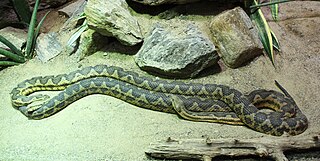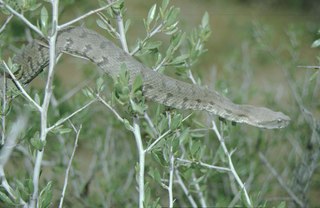
Gloydius himalayanus also known as the Himalayan pit viper or the Himalayan viper is a venomous pitviper species found along the southern slopes of the Himalayas in Pakistan, India and Nepal. No subspecies are currently recognized. Himalayan pit vipers have been found up to 4900m above sea level, which makes it the highest living snake ever found.

Macrovipera lebetinus, known as the blunt-nosed viper, Lebetine viper, Levant viper, and by other common names, is a viper species found in North Africa, much of the Middle East, and as far east as Kashmir. Like all other vipers, it is venomous. Five subspecies are currently recognized, including the nominate race described here.

Field's horned viper is a species of snake in the family Viperidae. The species is native to the deserts of the Middle East. Like all other vipers, it is venomous. It was previously considered a subspecies of the Persian horned viper. The main differences between this species and the Persian horned viper are in scalation and venom composition.

Macrovipera, known as the large Palearctic vipers, is a genus of vipers that inhabit the semideserts and steppes of North Africa, the Near and Middle East, and the Milos Archipelago in the Aegean Sea. Like all other vipers, they are venomous. These snakes are responsible for a number of bites in Africa and Western Asia every year. They have a reputation for being ill-tempered and can inject a lot of venom, which is why they should be considered as very dangerous. Two species are currently recognized.

Eristicophis is a monotypic genus created for the viper species, Eristicophis macmahonii, which is endemic to the desert region of Balochistan near the borders of Iran, Pakistan, and Afghanistan. Common names for the species include McMahon's viper, Asian sand viper, leaf-nosed viper, and whiskered viper. Like all other vipers, it is venomous. No subspecies are currently recognized.

Pseudocerastes is a genus of vipers endemic to the Middle East and Asia. It was originally created as a monotypic genus in 1896 by Boulenger for the species Pseudocerastes persicus, but three species are now recognised: the spider-tailed horned viper ; Persian horned viper and Field's horned viper. Like all other vipers, the members of this genus are venomous.

Vipera berus bosniensis, the Balkan cross adder or Bosnian viper, is a venomous subspecies of viper endemic to the Balkan Peninsula.
Echis jogeri, also known commonly as Joger's carpet viper, the Mali carpet viper, and Joger's saw-scaled viper, is a species of venomous snake in the family Viperidae. The species is endemic to Mali. There are no subspecies which are recognized as being valid.

Echis carinatus multisquamatus, known as the multiscale saw-scaled viper and transcaspian saw-scaled viper, is a viper subspecies found in Uzbekistan, Turkmenistan, Iran, Afghanistan, and Pakistan. Like all other vipers, it is venomous.

Echis carinatus sochureki is a venomous viper subspecies found in India, Pakistan, Afghanistan, Iran, and parts of the Arabian Peninsula.

The Moorish viper is a venomous viper species found in northwestern Africa. No subspecies are currently recognized.

The Milos viper, also known as the Cyclades blunt-nosed viper, is a subspecies of venomous snake in the family Viperidae. The subspecies is endemic to the Cyclades Archipelago of Greece in the Aegean Sea.
Macrovipera lebetinus cernovi, known as the Chernov blunt-nosed viper, is a viper subspecies endemic to Asia. Like all other vipers, it is venomous.
Macrovipera lebetinus transmediterranea is a viper subspecies endemic to North Africa. Like all other vipers, it is venomous.

Macrovipera lebetinus turanica is a venomous viper subspecies endemic to Asia.

Wagner's viper, known as the ocellate mountain viper, ocellated mountain viper, and Wagner's viper, is a species of venomous snake in the subfamily Viperinae of the family Viperidae. The species is native to eastern Turkey and northwestern Iran. There are no subspecies that are recognized as being valid.

The Persian horned viper, known as the Persian horned viper, false horned viper, and by other common names, is a species of vipers endemic to the Middle East and Asia. Like all other vipers, it is venomous.

Daboia is a genus of venomous vipers.














